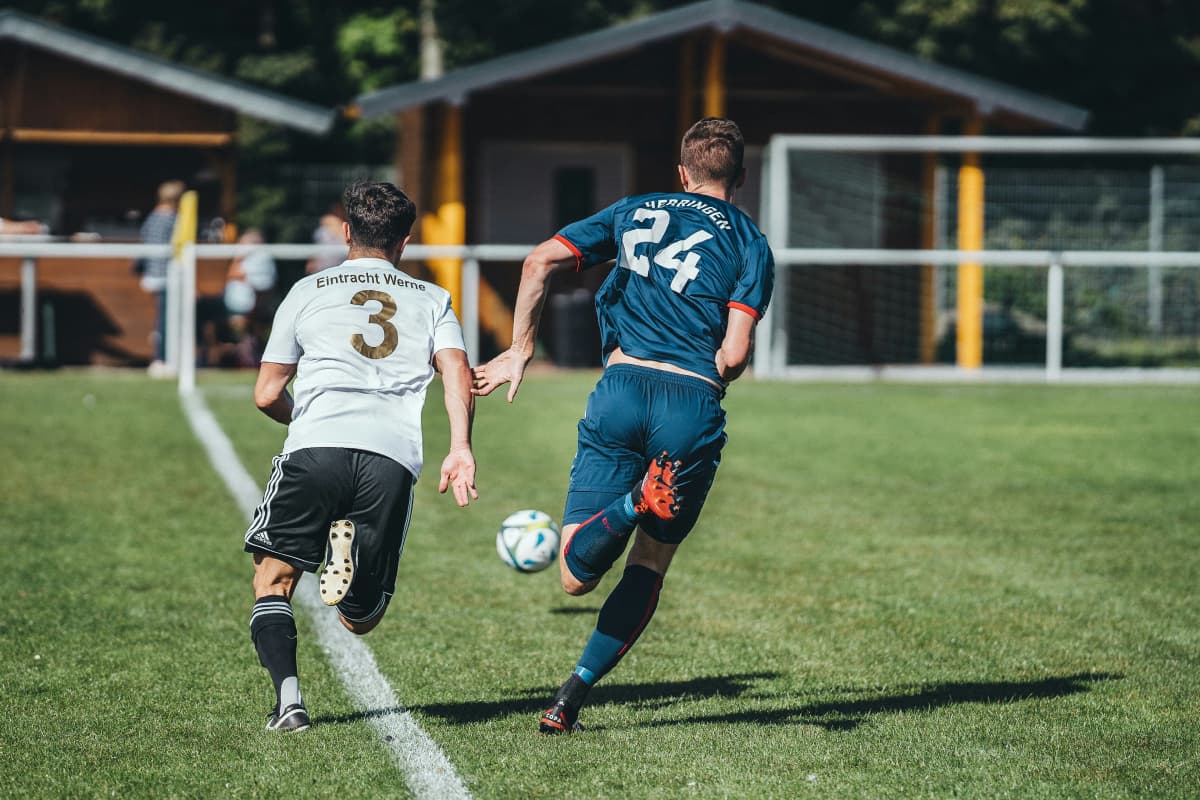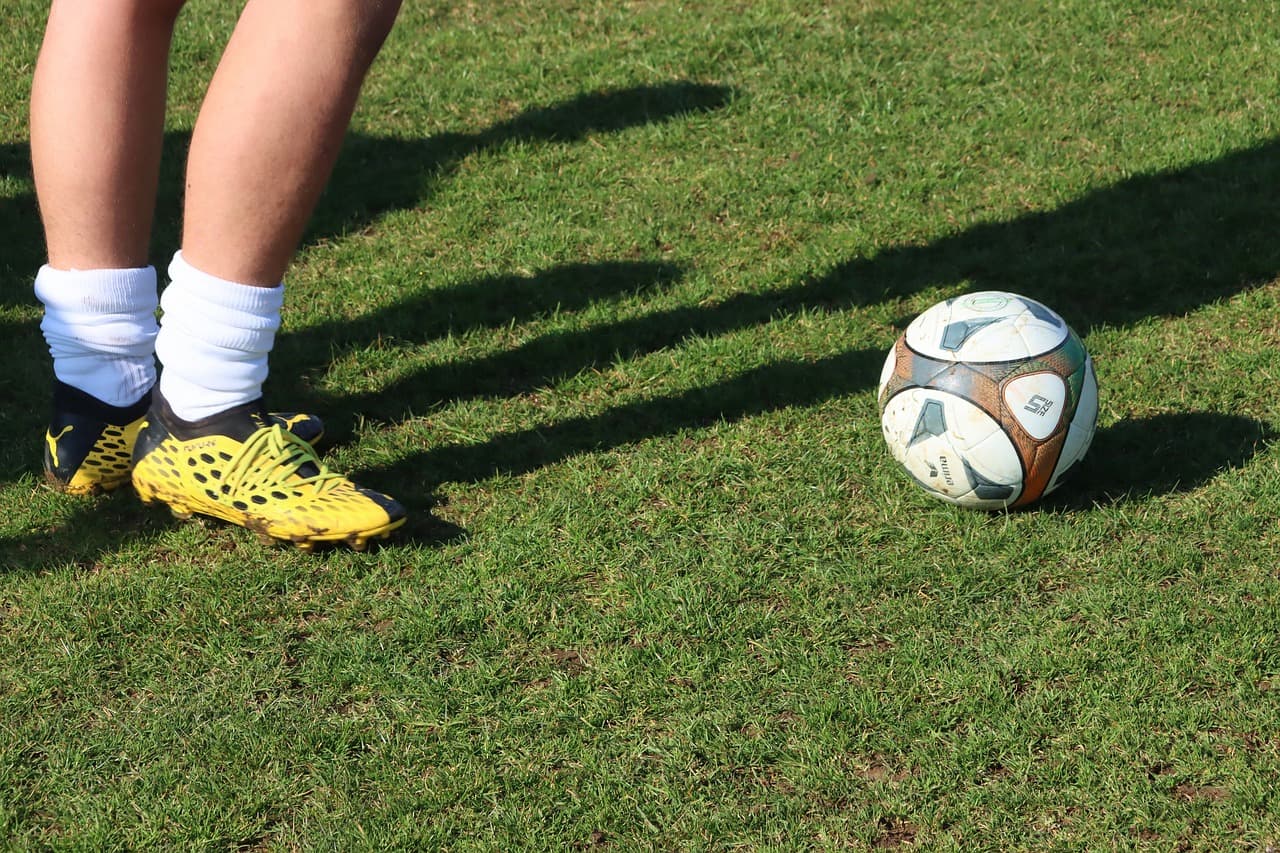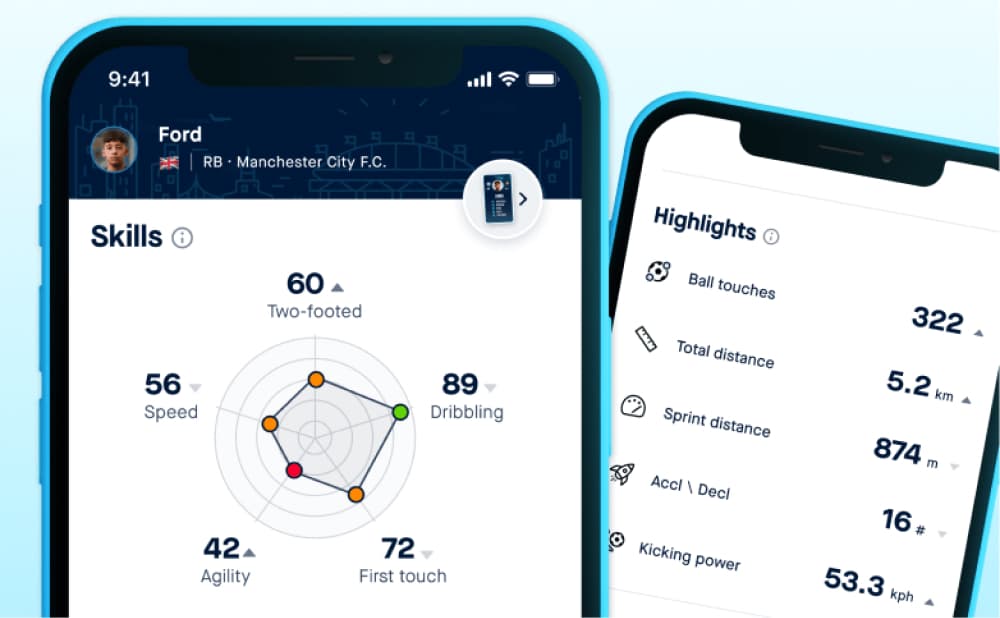Speed is crucial for soccer players. It influences every game aspect, from attacking and defending to reaction times.
The world’s fastest soccer players include Thierry Henry, Arjen Robben, and Gareth Bale—all reaching speeds higher than 35km on the field.
Nevertheless, understanding how to get faster for soccer involves focusing on various types of speed work, evaluating your current abilities, and including targeted training drills into your routine.
In this article, we will provide comprehensive tips and drills to increase your speed for soccer and become a more effective player:
Why Speed Matters in Soccer
Speed is important because it can be the difference between winning and losing a soccer match; it allows you to outrun opponents, reach the ball first, and make quick plays. Similarly, speed lets you exploit defensive gaps, create scoring opportunities, and track back to defend.
Midfielders—who frequently shuttle between defense and attack—benefit immensely from speed, allowing them to contribute effectively at both ends of the field. Also, a defender who can quickly close down on an attacker can prevent shots on goal or force them to make errors.
Moreover, soccer is a game of transitions; teams switch from defense to attack in seconds. Players who can rapidly adjust to these transitions with bursts of speed have a strategic advantage because they can capitalize on counter-attacking opportunities.
The 4 Different Types Of Speed
Speed in soccer is multi-dimensional, involving various aspects to enhance a your overall performance. Nevertheless, understanding these different types of speed is essential for targeted training and improvement.
Here are the 4 main types of speed in soccer:
Linear Speed
Linear speed is how fast a player can run straight; it’s essential for breakaways, counter-attacks, and catching up with opponents. For example, when a winger receives the ball near the sideline, their ability to sprint down the line can create goal-scoring opportunities.
Enhancing linear speed includes maximizing stride length and frequency and improving running mechanics.
Acceleration
Acceleration is the ability to reach top speed fast; in soccer, this is crucial for short sprints, starting from a stationary position, or rapidly changing direction. You must focus on drills including explosive starts and powerful leg drives to build acceleration.
Acceleration training includes resistance training, plyometrics, and exercises that enhance explosive leg power.
Agility
Agility is how quickly and efficiently you can change direction. You must weave through defenders, evade tackles, and adjust their positioning continually throughout a match, making agility highly important.
Agility training improves balance, coordination, and the ability to maintain speed while changing direction. In addition, agility drills often involve ladder drills, cone drills, and exercises that mimic the unpredictable movements required during a game.
Reaction
Reaction speed is how you respond quickly to the play around you, whether it’s an opponent’s move, a teammate’s pass, or an unpredictable ball bounce. Fast decision-making is as important as physical speed, and drills that simulate game situations can help enhance reaction times.
You can enhance reaction speed through drills with visual or auditory signals, forcing players to react and move accordingly.
Assessing Speed
Before you can improve your speed, you should assess your current abilities. Knowing your baseline measurement helps tailor your training program and track progress. Similarly, identifying strengths and weaknesses allows for more targeted improvements and effective goal setting.
Here are the 3 most common ways of assessing speed in soccer:
Timing Sprints
Timing 10, 20, and 30-yard sprints measures your linear speed and acceleration. You can use a a stopwatch or speed-tracking technology to record your times and set benchmarks for improvement.
These sprints are a straightforward way to measure how quickly a player can reach top speed from a standing start. Regularly timing these sprints allows players to track acceleration and linear speed.
PACER Test (Beep Test)
The PACER (Progressive Aerobic Cardiovascular Endurance Run) test is a easy way to measure speed, agility, and endurance. Although it doesn’t focus on soccer-specific skills, it delivers a suitable overall fitness indicator.
In the PACER test, players run back and forth between two points, keeping pace with audio beeps that gradually become faster. This test measures speed, cardiovascular endurance, and the ability to maintain high-intensity activity.
Yo-Yo Intermittent Recovery Test 1 (YYIRT1)
The YYIRT1 test measures your ability to perform high-intensity exercise regularly. It involves running between markers set 20 meters apart at increasing speeds, with short recovery periods.
The Yo-Yo test is relevant to soccer because it mimics the frequent sprints and brief recovery periods in a game.
11 Soccer Training Drills For Speed
Incorporating specific drills into your training routine can significantly improve your speed. Here are 11 effective soccer training drills:
Acceleration Drills
1. Flying Sprints
Start jogging and then accelerate to full speed for 20-30 yards, helping to improve acceleration and top-end speed. You’ll learn to transition smoothly from moderate to maximum effort by starting at a jog and then sprinting, which will improve various aspects of your game.
2. Push-Ups with Starts
Begin in a push-up position, then explode into a sprint. As a result, this combines strength training with acceleration work. Better still, it mimics game situations where you must explode into action, such as recovering from a fall or regaining balance after a tackle.
Top-End Speed Drills
3. Flying Starts
Begin with a few strides at a moderate pace and sprint at full speed for 20-30 yards. This allows transition from sub-maximal to maximal speed. It also trains the body to accelerate smoothly from a running star by improving overall top-end speed.
4. Interval Training
Alternate between sprinting and jogging for set intervals to improve speed endurance and the ability to maintain high speeds during a game. For example, sprint for 30 seconds, then jog for a minute and repeat; this training mimics the varying intensity levels of a soccer match.
Change of Direction Drills
5. Cone Drills
You should set up cones in various patterns and sprint through them, focusing on sharp turns and quick direction switches. This drill enhances agility and your ability to maintain speed when maneuvering around obstacles.
6. Ladder Drills
Use an agility ladder to perform various footwork patterns to enhancing coordination and quickness. Ladder drills are excellent for improving foot speed, balance, and coordination—all crucial for quick directional changes.
7. T-Drill
Ensure you set up cones in a T-shape. Sprint forward, shuffle sideways, backpedal, and sprint again. This drill combines speed and agility and stimulates the multi-directional movements required in soccer.
Drills to Build Explosive Speed
You should focus on exercises that enhance power and quickness if you want to build explosive speed in football.
8. Hill Sprints
Sprinting uphill increases resistance, builds leg strength, and boosts your explosive power. This enhances the muscles used for powerful sprints and acceleration and improves overall performance.
9. Plyometric Training
Exercises like box jumps, squat jumps, and bounding improve explosive strength and speed. Plyometrics focus on rapid muscle contraction and extension, which are essential for explosive movements in soccer.
Advanced Drills
10. Integrated Skill Drills
You should combine ball work with sprints. For example, dribble through cones and then sprint to a target. This integrates speed with ball control, ensuring you can maintain speed while handling the ball.
11. Reactive Sprint Drills
Recative sprint drills are where you react to visual or audio signals by sprinting in directed patterns. This creates speed and reaction time by simulating real-game scenarios where you must respond to changing conditions.
The Role of Technology in Speed Training
Technology plays a significant role in optimizing athletic performance, including speed training for soccer. Fortunately, advanced tools and devices can provide detailed insights into your training, helping you track progress and make necessary adjustments for continuous improvement.
Here are 4 prime examples:
GPS and Motion Tracking
GPS devices and motion tracking systems can measure various aspects of your movement—including distance covered, top speed, acceleration, and deceleration.
These metrics provide a comprehensive understanding of your physical capabilities and how they perform during matches and training sessions.
Likewise, coaches can identify areas where a player excels and where they need improvement. For example, if the data shows you’re is not reaching high speeds during a game, you can adjust your training to focus more on sprint drills and acceleration exercises.
Wearable Technology
Wearable devices, such as smartwatches and fitness trackers, offer real-time feedback on a player’s performance. They can monitor heart rate, step count, and calories burned, providing valuable information about a your physical condition and endurance levels.
Moreover, wearable technology lets you set specific goals and monitor progress. For example, you may reduce a 30-yard sprint time by a certain percentage and use the data from your device to track your progress.
Video Analysis
Video analysis is a powerful tool for improving speed and overall performance in soccer. For instance, recording training sessions and matches allow you and your coaches to review footage and analyze movements, techniques, and decision-making.
You can also identify flaws in running mechanics, such as inefficient arm movement or improper posture, and make the necessary corrections. Video analysis also helps in understanding the tactical aspects of the game, such as positioning and movement off the ball, which can indirectly impact a your speed and effectiveness on the field.
Specialized Training Equipment
Various specialized training equipment can aid in speed development for soccer. For instance, resistance bands, sleds, and parachutes add resistance to running drills by helping to build strength and explosive power.
Incorporating these tools into training sessions can make drills more challenging and effective, leading to better results. Additionally, using equipment that provides resistance helps simulate game-like conditions, making you better prepared for the physical demands of a match.
Track Your Speed Training Using Playermaker Technology
To maximize your speed training, you should consider using technology like Playermaker’s smart soccer tracker. This advanced tracking system provides detailed data on your performance and helps you monitor progress and adjust your training regimen accordingly.
The device attaches to your footwear, capturing data on every movement you make on the field. It tracks metrics—such as distance covered, top speed, acceleration, and deceleration—providing a comprehensive overview of your physical performance.
Using this data, you can identify your strengths and weaknesses, tailor your training programs to address specific areas, and set realistic goals for improvement.
Integrating Speed Training into Your Routine
To effectively improve your speed for soccer, it’s important to integrate speed training into your routine. This involves structuring your training sessions to include a balance of different drills and exercises that target all aspects of speed.
Here are some examples:
1. Periodization
Periodization is the systematic planning of athletic training. It involves dividing the training program into phases—each with specific goals and focuses. For speed training, periodization can help develop speed, strength, and endurance over time.
For example, a typical periodization plan might include:
- Preparation Phase: Focus on building a solid fitness foundation with general conditioning and strength training.
- Base Phase: Introduce specific speed and agility drills, gradually increasing intensity and volume.
- Build Phase: Increase the complexity and intensity of drills, incorporating more sport-specific exercises.
- Peak Phase: Focus on maximizing speed and performance with high-intensity, game-like drills.
- Recovery Phase: Allow the body to rest and recover, incorporating light training and active recovery exercises.
2. Combining Strength and Speed Training
Strength training is a crucial component of speed development. Stronger muscles generate more force, leading to faster acceleration and greater overall speed.
You should incorporate exercise—such as squats, deadlifts, lunges, and plyometrics—into your routine to build lower body strength and explosive power.
3. Consistency and Progression
Consistency is key to any training program; regularly performing speed drills and exercises ensures continuous improvement. Aim to include speed training in your routine at least 2-3 times per week, allowing for adequate rest and recovery between sessions.
Progression is also important. You should gradually increase the intensity, volume, and complexity of your drills as you become more comfortable and proficient.
4. Recovery and Nutrition
Proper recovery and nutrition are essential for optimizing performance and preventing injury. Theefore, ensure you get adequate rest, hydration, and nourishment to support your training efforts.
In addition, stay hydrated by drinking water throughout the day, and consider using sports drinks during intense training sessions to replenish electrolytes.
Final Thoughts
Whether you’re a forward-looking to outpace defender, a midfielder seeking to cover more ground, or a defender aiming to shut down opponents—speed is critical for high performance on a soccer field.
With the right training, assessment, and technology, you can become a faster, more dynamic player.
If you use Playermaker’s smart tracker technology to monitor your progress, you’ll be well on your way to getting faster for soccer and reaching new performance on the field.









